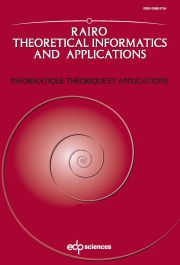Crossref Citations
This article has been cited by the following publications. This list is generated based on data provided by Crossref.
Mignosi, Filippo
Shallit, Jeffrey
and
Wang, Ming-wei
2001.
Mathematical Foundations of Computer Science 2001.
Vol. 2136,
Issue. ,
p.
512.
Justin, Jacques
and
Pirillo, Giuseppe
2002.
On a characteristic property of ARNOUX–RAUZY sequences.
RAIRO - Theoretical Informatics and Applications,
Vol. 36,
Issue. 4,
p.
385.
BERSTEL, JEAN
2002.
RECENT RESULTS ON EXTENSIONS OF STURMIAN WORDS.
International Journal of Algebra and Computation,
Vol. 12,
Issue. 01n02,
p.
371.
Justin, Jacques
and
Pirillo, Giuseppe
2002.
Episturmian words and episturmian morphisms.
Theoretical Computer Science,
Vol. 276,
Issue. 1-2,
p.
281.
Simpson, R.
and
Tijdeman, R.
2003.
Multi-dimensional versions of a theorem of Fine and Wilf and a formula of Sylvester.
Proceedings of the American Mathematical Society,
Vol. 131,
Issue. 6,
p.
1661.
Tijdeman, R.
and
Zamboni, L.
2003.
Fine and Wilf words for any periods.
Indagationes Mathematicae,
Vol. 14,
Issue. 1,
p.
135.
Cautis, Sabin
Mignosi, Filippo
Shallit, Jeffrey
Wang, Ming-wei
and
Yazdani, Soroosh
2003.
Periodicity, morphisms, and matrices.
Theoretical Computer Science,
Vol. 295,
Issue. 1-3,
p.
107.
Richomme, G.
2003.
Conjugacy and episturmian morphisms.
Theoretical Computer Science,
Vol. 302,
Issue. 1-3,
p.
1.
Richomme, Gwenael
2003.
Some algorithms to compute the conjugates of Episturmian morphisms.
RAIRO - Theoretical Informatics and Applications,
Vol. 37,
Issue. 1,
p.
85.
Justin, Jacques
2005.
Episturmian morphisms and a Galois theorem on continued fractions.
RAIRO - Theoretical Informatics and Applications,
Vol. 39,
Issue. 1,
p.
207.
Constantinescu, Sorin
and
Ilie, Lucian
2005.
Generalised fine and Wilf's theorem for arbitrary number of periods.
Theoretical Computer Science,
Vol. 339,
Issue. 1,
p.
49.
Luca, Aldo de
and
Luca, Alessandro De
2006.
Pseudopalindrome closure operators in free monoids.
Theoretical Computer Science,
Vol. 362,
Issue. 1-3,
p.
282.
Tijdeman, Rob
2006.
More Sets, Graphs and Numbers.
Vol. 15,
Issue. ,
p.
381.
Holub, Štěpán
2006.
On multiperiodic words.
RAIRO - Theoretical Informatics and Applications,
Vol. 40,
Issue. 4,
p.
583.
Blanchet-Sadri, F.
Corcoran, Kevin
and
Nyberg, Jenell
2008.
Periodicity properties on partial words.
Information and Computation,
Vol. 206,
Issue. 9-10,
p.
1057.
Blanchet-Sadri, F.
Bal, Deepak
and
Sisodia, Gautam
2008.
Graph connectivity, partial words, and a theorem of Fine and Wilf.
Information and Computation,
Vol. 206,
Issue. 5,
p.
676.
Glen, Amy
and
Justin, Jacques
2009.
Episturmian words: a survey.
RAIRO - Theoretical Informatics and Applications,
Vol. 43,
Issue. 3,
p.
403.
Bucci, Michelangelo
de Luca, Aldo
De Luca, Alessandro
and
Zamboni, Luca Q.
2009.
On θ-episturmian words.
European Journal of Combinatorics,
Vol. 30,
Issue. 2,
p.
473.
Paquin, Geneviève
2009.
On a generalization of Christoffel words: epichristoffel words.
Theoretical Computer Science,
Vol. 410,
Issue. 38-40,
p.
3782.
de Luca, Aldo
and
Zamboni, Luca Q.
2010.
On graphs of central episturmian words.
Theoretical Computer Science,
Vol. 411,
Issue. 1,
p.
70.

